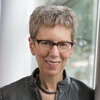Joel Kincaid, 2017; Terry Gross (Fresh Air); CC Liu, Ashley Wells (eds.), Wisdom Quarterly
 |
| How can I help animals? |
But what about chickens?
| "Cage-free" is a sham in practice but sounds so good people buy it (Charlie Neibergall/AP). |
.
They're [chemically altered and] bigger and more "breasty," says public health journalist Maryn McKenna — and that's by [genetically modified and industrial] design.
"In the United States, [flesh eaters] much prefer to eat white meat, and so [industrial scale killers] have bred chickens and genetically redesigned chickens in order for them to have a lot of breast meat," McKenna says.
 |
| I'm Gross, not chicken |
Many large poultry farms [force] feed antibiotics to their chickens in an effort to prevent disease. But McKenna says that humans who eat those chickens are at risk of developing not only antibiotic-resistant gastrointestinal infections but urinary tract infections as well.
She chronicles the use of antibiotics in the poultry industry in her new book, Big Chicken. More + AUDIO
She chronicles the use of antibiotics in the poultry industry in her new book, Big Chicken. More + AUDIO


















































































































































































































































No comments:
Post a Comment